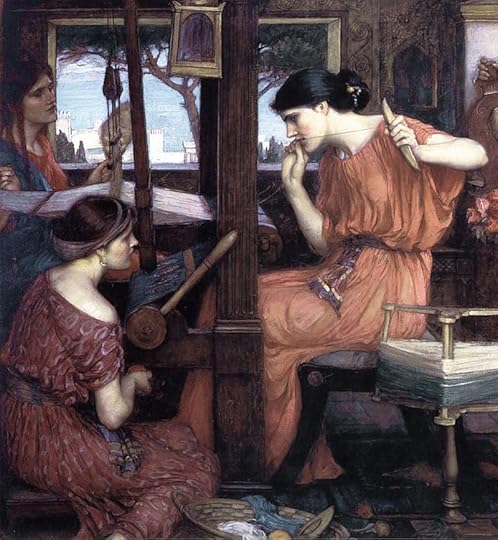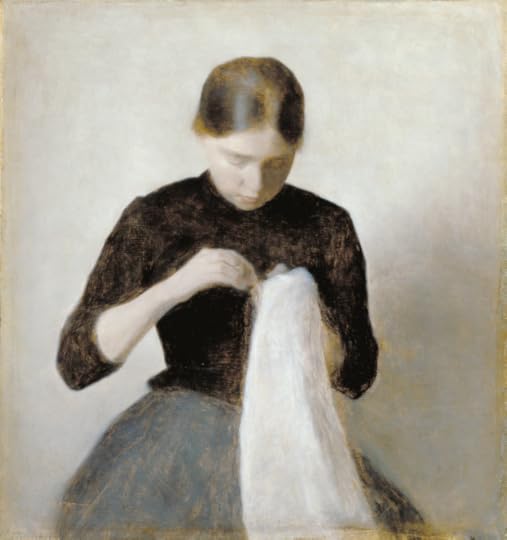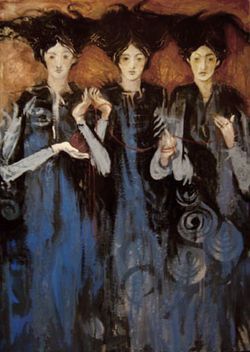Spinning Straw into Gold
"A thread now most often means a line of conversation via e-mail or other electronic means, but thread must have been an even more compelling metaphor when most people witnessed or did the women's work that is spinning. It is a mesmerizing art, the spindle revolving below the strong thread that the fingers twist
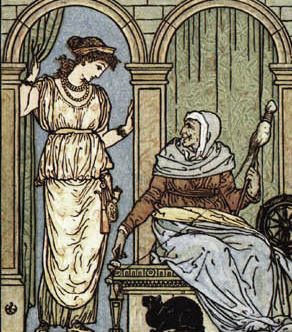 out of the mass of fiber held on an arm or a distaff. The gesture turns the cloudy mass of fiber into lines with which the world can be tied together. Likewise the spinning wheel turns, cyclical time revolving to draw out the linear time of a thread. The verb to spin first meant just this act of making, then evolved to mean anything turning rapidly, and then it came to mean telling a tale.
out of the mass of fiber held on an arm or a distaff. The gesture turns the cloudy mass of fiber into lines with which the world can be tied together. Likewise the spinning wheel turns, cyclical time revolving to draw out the linear time of a thread. The verb to spin first meant just this act of making, then evolved to mean anything turning rapidly, and then it came to mean telling a tale.
"Strands a few inches long twine together into a thread of yarn that can go on forever, like words becoming stories. The fairy-tale heroines spin cobwebs, straw, nettles into whatever is necessary to survive. Scheherazade forestalls her death by telling a story that is like a thread that cannot be cut; she keeps spinning and spinning, incorporating new fragments, characters, incidents, into her unbroken, unbreakable narrative thread. Penelope at the other end of the treasury of stories prevents her wedding to any one of her suitors by unweaving at night what she weaves by day on her father-in-law's funeral garment. By spinning, weaving, and unraveling, these women master time 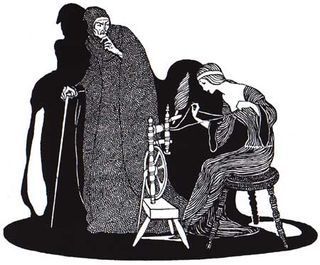 itself, and though master is a masculine word, this mastery is feminine.
itself, and though master is a masculine word, this mastery is feminine.
"Women were spinsters before the word became pejorative, when distaff meant the female side of the family. In Greek
mythology, each human life is a thread that the three Moirae, or Fates,
spin, measure, and cut. With Rumpelstiltskin's help, the unnamed
fairy-tale heroine spins straw into gold, but the wonder is that every
spinner takes the amorphous mass before her and makes thread appear,
from which comes the stuff that contains the world, from a fishing net
to a nightgown. She makes form out of formlessness, continuity out of
fragments, narrative and meaning out of scattered incidents, for the
storyteller is also a spinner or weaver and a story is a thread that
meanders through our lives to connect us each to each and to the purpose
and meaning that appear like roads that we must travel."
- Rebecca Solnit (The Faraway Nearby)
"Wanted: a needle swift enough to sew this poem into a blanket." - Charles Simic
Each day she weaves for twelve brothers, twelve golden shirts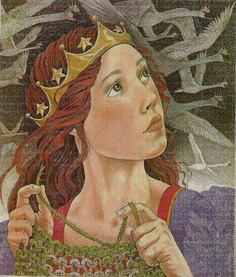 twelve pairs of slippers, twelve sets of golden mail.
twelve pairs of slippers, twelve sets of golden mail.
She sleeps under olive trees, praying for rescue.
In her dreams doves fly in circles, crying out her name.
For a hundred years she is turned into a golden bird,
hung in a cage in a witch's castle. Her brothers
are all turned to stone. She cannot save them,
no matter how many witches she burns.
She weeps tears that cannot be heard
but turn to rubies when they hit the ground.
She lifted her hand against the light
and it became a feathered wing....
- Jeannine Hall Gailey (from "Becoming the Villainess")
Fire shadows on the wall,
A hand rises, falls, as steady as a heart beat,
Threading the strands of life.
This is the warp thread, this the woof
This the hero-line, this the fool.
Needle and scissors, scissors and pins,
Where one life ends, another begins.
- Jane Yolen (from "The Fates")
“Writing fiction is the act of weaving a series of lies to arrive at a greater truth.” - Khaled Hosseini
The spinning, weaving, and sewing art above is: "Rumplestiltskin" by Paul O. Zelinksy (American); "Sleeping Beauty" by Walter Crane (English, 1845-1915); "Sleeping Beauty" by Jennie Harbour (English, 1893-1959); a detail from "Penelope and the Suitors" by John William Waterhouse (English, 1849-1917); "The Wild Swans" by Nadezhda Illarionova (Russian); "The Wild Swans" by Mercer Mayer (American) & Eleanor V. Abbott (English, 1909-1972); "The Wild Swans" by Adrienne Segur (French/Greek, 1901-18981); "The Wild Swans" by Susan Jeffers (American); "Sleeping Beauty" by John D. Batten (English, 1860-1932); "Woman Sewing" by Vilhelm Hammershøi (Danish, 1864-1916); "Woman Sewing in an Interior" by Marie-Gabriel Biessy (French, 1953-1945); "Three Muses" by Oliver Hunter (Australian); "Two Girls Sewing at the Window" and "Loom and Thread" by Carl Larsson (Swedish, 1853-1919).
Terri Windling's Blog
- Terri Windling's profile
- 708 followers



